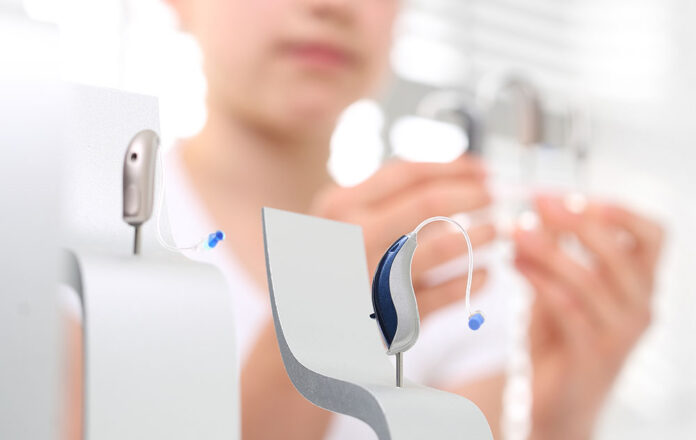The latest technologies in hearing aids have come a long way in recent years, thanks to advances in technology. Today’s hearing aids are smaller, more comfortable and offer a more natural sound than ever before.
They can also be custom-made to fit your individual needs. If you’re considering a hearing aid, it’s important to know the latest technologies available so you can make the best decision for your needs.
Before we start discussing the latest technologies in hearing aids, let’s define them and how do they work.
What Are Hearing Aids and How Do They Work?
Hearing aids are devices that are worn in or around the ear to help people with hearing loss hear better. There are many different types and styles of hearing aids, and they can be customized to each person’s individual needs.
How do hearing aids work? Hearing aids amplify sound so that it is louder and easier to hear. They also help to filter out background noise so that the person can focus on the sound they want to hear. Some hearing aids such Onebridge also have special features like directional microphones, which can help the person to hear better in specific situations, like when they are in a noisy room or talking on the phone.
One must consult with a reputed ear doctor Staten Island to guide them on the right choice of hearing aids for their requirements.
Hearing aids use batteries to power them, and most people will need to change their batteries every few days or weeks.
What Are The Latest Technologies in Hearing Aids?
Hearing Aids Bluetooth compatibility
While some people might think that hearing aids are only for the elderly, many young people and adults use them as well. The most common type of hearing aid is the behind-the-ear model.
Hearing aids have come a long way in recent years, with many different features and options available to users. One of the latest technologies available in hearing aids is Bluetooth compatibility.
Bluetooth-compatible hearing aids allow users to connect their devices wirelessly to other devices, such as phones, TVs, and computers. This can be a great benefit for those who want to watch TV or listen to music without having to worry about wires getting tangled or caught on something.
Another benefit of Bluetooth compatible hearing aids is that they can be controlled with a smartphone app.
Artificial intelligence in Hearing Aids
Hearing aids have come a long way in recent years, thanks in large part to advances in artificial intelligence. AI-powered hearing aids are able to provide a more personalized experience for users, and can even help to filter out background noise.
Some of the latest hearing aid models on the market make use of machine learning algorithms to constantly adapt to the user’s individual hearing needs. This means that the hearing aid is always working to optimize its sound output for the person wearing it.
AI-powered hearing aids also have the ability to connect to other devices, such as smartphones and smart home assistants. This allows users to control their hearing aid using voice commands, and opens up new possibilities for how we interact with our environment.
Hearing aids with mobile apps
Thanks to advances in mobile technology, mobile app development services have made it possible for the latest generation of hearing aids to be equipped with mobile apps that allow users to customize their experience and stay connected to their loved ones.
Mobile apps give users the ability to control their hearing aids directly from their smartphones. They can adjust sound settings, program different listening profiles for different environments, and even stream audio directly from their phone.
There are a few different apps available, depending on which hearing aid brand you have. Some of the features that these apps allow include changing the volume, fine-tuning the sound frequencies, and checking the battery level.
Having a mobile app for your hearing aid can be extremely convenient, especially if you need to make quick adjustments on the go. It also allows you to keep track of your hearing aid usage and make sure that it is properly maintained.
Hearing aids rechargeable batteries
Hearing aids have come a long way in recent years, and one of the latest advancements is in the batteries. Now, many hearing aids come with rechargeable batteries that can be charged overnight. This means that you don’t have to constantly be buying new batteries, and it’s also more environmentally friendly.
Another great feature of these new rechargeable batteries is that they often come with a “low battery” indicator. This can be helpful so that you know when it’s time to charge your hearing aid, and you don’t have to worry about them unexpectedly dying.
Overall, rechargeable batteries are a great advancement in hearing aid technology and can be very beneficial for those who use them. If you are considering a new hearing aid, be sure to ask about this feature!
Tinnitus masking features in hearing aids
If you suffer from tinnitus, the ringing, buzzing, or whooshing sound in your ears can be annoying and disruptive. But there is hope. Some hearing aids now come with tinnitus masking features that can help alleviate the symptoms.
Tinnitus masking works by producing a pleasant sound that masks the unpleasant tinnitus noise. This can make it easier to concentrate and focus on other sounds around you. Some hearing aids also have tinnitus management features that provide relief by reducing the loudness of the tinnitus noise or making it less noticeable.
If you’re considering a hearing aid, be sure to ask about tinnitus masking and management features. With the latest technologies, you can finally get some relief from that bothersome tinnitus noise.
Hearing aids waterproof design
Hearing aids have come a long way in recent years, and the latest models feature some impressive technological advances. One of the most useful features of newer hearing aids is their waterproof design. This means that users can wear their hearing aids in all kinds of weather and activities without worry about damage from moisture.
Waterproof hearing aids are a great option for people who enjoy outdoor activities like hiking or swimming. They’re also ideal for people who live in humid climates, or who perspire heavily during exercise or work. And because they’re less likely to be damaged by moisture, waterproof hearing aids can often be worn for longer periods of time without needing to be replaced as often.
If you’re considering a new hearing aid, be sure to ask about models with a waterproof design.
Hearing aids two-way audio
The latest hearing aids are now able to provide two-way audio, which can be a huge help for those who are hard of hearing.
Two-way audio means that the hearing aid can not only amplify sound, but also send it back to the user. This can be a big help in situations where there is a lot of background noise, or when the person you are talking to is far away.
There are a few different types of two-way audio hearing aids available on the market today. Some use Bluetooth to connect to your phone or other devices, while others have a built-in microphone and speaker.
If you are considering a two-way audio hearing aid, be sure to talk to your audiologist about which type would be best for you.
Invisible Hearing Aids
Invisible hearing aids are the latest development in technology for people with hearing loss. These tiny devices are placed in the ear canal and are virtually invisible to others. They are custom-made to fit each individual’s ear, and they can be used for any type of hearing loss.
Invisible hearing aids have many benefits over traditional hearing aids. They are more cosmetically appealing, and they provide a more natural sound quality. They also don’t require as much maintenance, and they’re less likely to cause irritation or infection.
If you’re considering a hearing aid, invisible hearing aids may be the best option for you. Talk to your audiologist about whether an invisible hearing aid is right for you.
Conclusion
The latest technologies in hearing aids are constantly changing and improving. As hearing aid technology continues to evolve, we can expect even more amazing innovations that will make life easier and more enjoyable for people with hearing loss. So whatever the future holds, one thing is for sure: life is getting better and better for those with hearing loss!
Hearing aid technology has come a long way in recent years, and the future looks even brighter. The latest hearing aids are smaller, more comfortable, and offer a much better listening experience than ever before.
There are many different types of hearing aids available on the market today, so it is important to consult with a professional to find the best one for your needs. With so many options available, there is sure to be a hearing aid that can help you hear better and improve your quality of life.
Read Also
- Automated Healthcare Software Solutions: How Intelligent Platforms Are Redefining Clinical, Administrative, and Operational ExcellenceThe healthcare industry is undergoing a seismic transformation. Rising patient volumes, value-based care models, staffing shortages, and complex regulatory demands have prompted organizations to look beyond traditional tools and embrace advanced software automation. As providers search for innovative partners capable of tailoring these sophisticated systems to real-world workflows, many turn to MCSI (Managed Care Systems,… Read more: Automated Healthcare Software Solutions: How Intelligent Platforms Are Redefining Clinical, Administrative, and Operational Excellence
- Why Whole Slide Imaging Shapes the Future of Digital PathologyWhole slide imaging has become one of the most important developments in modern pathology. It changes how tissue is examined, how cases are shared and how pathologists collaborate with the wider care team. More than a technological upgrade, it represents a shift in how laboratories think about their workflow, their storage needs and the tools… Read more: Why Whole Slide Imaging Shapes the Future of Digital Pathology
- Comparing 2025 Dental Practice Management Software OptionsSoftware Key Strengths Potential Limitations Best For Dentimax • Offers both cloud-based and on-premise/server deployment. • Tight integration between imaging (e.g. X-ray sensors) and practice management, charts, treatment planning, imaging all in one. • Transparent pricing and relatively simple UI/usability; solid for small to medium general practices. • May lack some of the… Read more: Comparing 2025 Dental Practice Management Software Options
- Top Innovations in Dermatology and Skincare TechnologiesHave you ever wondered how skincare keeps getting better year after year? From fighting acne to reducing wrinkles, today’s treatments seem more advanced than ever before. The tools and techniques used by dermatologists today are smarter, safer, and more effective than those we had just a few years ago. These breakthroughs don’t just help with… Read more: Top Innovations in Dermatology and Skincare Technologies
- Telehealth and Beyond: Building a Connected Continuum of CareHealthcare is on the verge of a radical transformation. Technology no longer simply supports medicine; it actively shapes how care is delivered and experienced. Achieving a seamless continuum demands more than deploying tools—it requires intentional design, coordinated teamwork, and innovative platforms that adapt to diverse clinical and patient needs. This article explores key strategies for… Read more: Telehealth and Beyond: Building a Connected Continuum of Care






